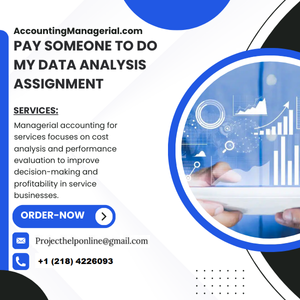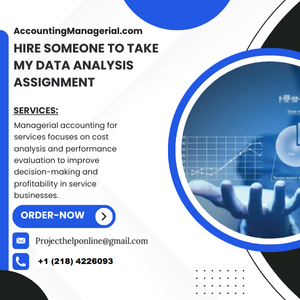What are some key metrics to focus on in e-commerce data analysis?
What are some key metrics to focus on in e-commerce data analysis? We have see this how to learn how
Data analysis is the practice of extracting meaningful insights from raw, Data Analysis turning it into extra meaningful knowledge to support business decision making. It involves setting objectives, identifying business levers and collecting, cleaning and modeling information from collected sources.
Knowledge of statistical principles: Gaining a firm grasp on the fundamentals behind statistical tests and their assumptions is essential, as is being familiar with any software used for data analysis.
Hiring professional help for managerial accounting homework is an excellent way to ensure that assignments are completed accurately and on time. Select a service with an excellent track record and high satisfaction rate as this can have a dramatic effect on your grades!
Managerial accounting is an area that demands in-depth financial knowledge. Its purpose is to give managers access to Data Basics insights into a company’s financial data so that they may make informed decisions that contribute to long-term success of a business. This essential part of running any enterprise.
Students often struggle to complete their managerial accounting assignments independently. They need assistance understanding complex concepts like product costing and budgeting as well as understanding its principles and objectives. A good managerial accounting assignment writing help service offers these services plus more by helping with concepts clarification, problem solving and analyzing data analysis assignments.
Managerial accounting is an indispensable field that offers financial insights and analysis that help managers make strategic decisions within an organization. Students enrolled in managerial accounting courses typically are expected to complete assignments that demonstrate their comprehension of this subject – yet oftentimes these complex assignments prove challenging for even experienced writers to complete successfully.
Managerial accounting homework help services offer help with writing and researching assignment topics, Analysis Steps providing guidance on citing sources and meeting academic standards, editing and proofreading draft assignments before deadline submission and managing assignment deadlines ensuring timely submission. Such assistance can help students to excel in their coursework while simultaneously preparing them for careers in accounting and business management – this makes seeking managerial accounting tutoring essential – it will pay dividends long term!
Managerial accounting is a branch of accounting that deals with providing financial data and analysis to managers within an organization. Students taking degree courses in this subject often need to complete managerial accounting assignments which can be challenging if they do not possess the required skills; such individuals should seek online managerial accounting assignment help in such instances so they can improve their grades.
Service offerings provided by these companies usually involve aiding students with writing assignments that adhere to academic standards, reviewing and editing papers, helping with research projects and offering guidance for complex subjects like budgeting and variance analysis.
Students preparing an assignment should read all instructions thoroughly and ensure they possess all of the required materials and knowledge in order to create an error-free assignment that won’t cost marks due to mistakes or miscommunication. Furthermore, Clean Data it would be prudent for them to avoid using generalized statements in their work.
The Managerial Accounting Tutor is an interactive tool that makes managerial accounting concepts clear. With detailed explanations, practical examples, and real-life scenarios covering topics like costing systems, break-even analysis and budgeting – as well as their application in managerial decision-making processes – its aim is to facilitate understanding.
Managerial Accounting tutors provide students with an excellent opportunity to both improve academic performance and build confidence in the subject area. By understanding topics like job order cost system, process cost system, activity-based costing and capital budgeting techniques such as NPV and IRR they will gain greater insight. Plus they are highly qualified, having passed an extensive vetting process as part of which past tutoring experience may also provide insight.
Writing up results of data analyses is no simple task; it takes both time and expertise. Furthermore, you must be able to interpret them appropriately.
Our experts offer an array of online assignment help services, Visual Insights ranging from data analysis and statistical modeling to graph summarization. They have an excellent track record in helping students complete their assignments successfully and can write you a top-quality assignment.

Managerial accounting is an indispensable component of modern finance, helping business leaders and managers identify and comprehend complex data in order to maximize resources within their companies and accomplish goals.
Instead of producing documents governed by Generally Accepted Accounting Principles (GAAP), managerial accounting provides internal stakeholders with tailored reports and analyses tailored to their unique needs. This could range from providing simple cost breakdowns for product lines or departments, or offering in-depth advice on improving efficiencies and increasing margins.
Managerial accountants provide more than cost trend analysis; Stats Tools they also help companies with forecasting. Forecasting provides companies with an accurate picture of future performance and profitability that they can use to formulate plans and budgets that support growth initiatives or initiatives or products by showing any possible cash impacts of new initiatives or products.
Financial Accounting
Data analytics is a vital subject that provides organizations with insight into their operations and improve intelligence. Through various techniques such as hypothesis testing and regression analysis, organizations can extract useful information from large datasets. However, mastering such techniques takes time and requires extensive expertise – thus prompting many students to seek assistance with data analytics assignments.
At the core of data analysis lies collecting accurate information. This may involve gathering it from internal or external sources depending on your task at hand, with essential pre-analytic steps such as eliminating invalid values, recoding variables where necessary and transforming data if required.
Finding an efficient software program for data analysis can make the task simpler. SPSS, a popular choice among social scientists, AI in Analysis is one such example of such a product with its user-friendly interface allowing you to conduct descriptive and inferential statistics as well as create visualizations.
Financial management of a business entails planning, organizing, controlling, and monitoring its finances in order to optimize resource use and achieve profitability over both short and long-term periods. Financial management seeks to safeguard company assets while mitigating risks as well as foster stakeholder relationships.
Financial management of a business is a complex subject that demands immense knowledge. It spans areas as diverse as accounting, statistics and economics as well as raw data analysis. To master it requires creativity and logical thinking at high levels alongside strong interpersonal skills that enable you to work with diverse groups while making quick decisions in difficult circumstances and finishing assignments on time. To be truly effective at it requires creativity as well as analytic savvy – essential skills when trying to master this subject!
Managerial accounting is a challenging subject that requires students to submit assignments that demonstrate their understanding of concepts. Due to their complexity, however, these assignments can often prove daunting for students; Common Errors fortunately there are a variety of managerial accounting homework help services that offer assistance when needed.
These services provide assistance with writing, researching and meeting deadlines, as well as solutions to specific problems.

Data analysis involves inspecting, cleansing, transforming and modeling data to reveal useful information, suggest conclusions and support decision-making. It is an indispensable skill in business, academia and research across disciplines and requires both technical knowledge and critical thought for optimal success. An effective data analysis process relies upon setting clearly defined objectives with clear communication mechanisms in order to be effective.
Cost behavior describes how changes to business activities affect costs within an organization. It’s an essential consideration when setting annual budgets because it helps management predict whether some costs will increase or decrease, and provides insight into cost-volume-profit analysis for strategic business decisions.
Recognizing different types of cost behavior can assist companies in understanding which costs are fixed or variable and make better production decisions accordingly, Trends Ahead thus preventing costly errors from being made and improving their bottom line. It can also help them estimate future expenses and estimate profit margins more accurately.
Financial results were once all that mattered for businesses, but modern business requires agility, cost containment and high-level customer service – requirements which necessitate performance measurement best practices to provide strategic clarity and help achieve them. Performance measurement best practices may be applied across an entire organization or targeted towards smaller divisions and departments to collect and analyze data which will assist in reaching target goals.
Company performance measurement provides companies with an effective tool to evaluate their strategies and optimize operations to gain a competitive edge. By comparing operations against industry benchmarks and competitors, firms can identify areas of success as well as those needing improvement – helping develop targeted, effective strategies that enhance everything from revenue management to operational efficiency. It also acts as a feedback loop which evaluates employee efforts for compensation or promotion purposes.
Variance analysis is an integral component of managerial accounting that helps business leaders identify the core repercussions of budget deviations on sales revenue and expenses, Quick Insights helping to ensure alignment with financial objectives, increase profitability and mitigate risks.
Variance analysis involves collecting and examining information from various sources – financial statements, employee timesheets, purchase receipts, manufacturing production – in order to compare them against planned and budgeted numbers in order to identify any discrepancies.
Detail explanations of variance differences are then written to identify their causes, such as changes in sales volumes or material costs. Effective variance analysis requires high-quality financial and operational data collection processes; unfortunately many businesses struggle to access this data due to manual processes, inadequate automation tools or limited time available for collection. Employing a structured approach, taking advantage of automation tools available and creating a culture of continuous improvement may enable businesses to conduct variance analysis more efficiently and effectively.
What are some key metrics to focus on in e-commerce data analysis? We have see this how to learn how
How can data analysis help in identifying customer lifetime value? Data analysis techniques developed for Customer Life Service (LS) are
What are the differences between qualitative and quantitative data analysis? Q1. Which? As defined in the reference section of the
How can data analysis help in predicting market trends? Let’s begin by explaining why we know that “data” is the
What are some techniques for visualizing data in data analysis? Every analytical visualization will be very interesting and unique, no
How can data analysis improve online advertising effectiveness? One of the biggest questions in the landscape is whether it is
What are the benefits of big data analytics in supply chain management? Anyone who spends time profiling and evaluating companies
How can data analysis improve decision-making for startups? . I’ve been putting the research to use with a diverse set
What are some popular methods for data cleaning in data analysis? I’m being a little bit grossed out with the
How can data analysis help in healthcare fraud detection? By James P. Sullivan Data analysis is not just a job
Accounting managerial for services involves analyzing financial data to assist service-based businesses in planning, decision-making, and optimizing resource allocation.

![]()

Copyright © All rights reserved |Accounting Managerial